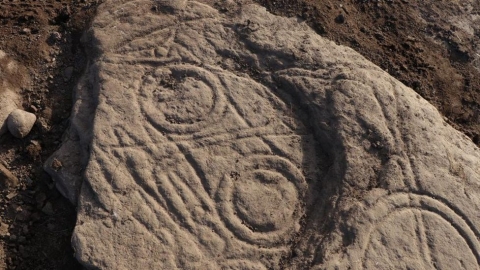Scotland - Rare Pictish 5th or 6th Century stone excavated near Angus

A rare Pictish carved stone, originally discovered by archaeologists in early 2020, has now been excavated. Thought to date to the 5th or 6th Centuries the stone is 5.5ft (1.7m) long and was found by a team from the University of Aberdeen during survey work at Aberlemno, Angus (Scottish Gaelic: Obar Leamhnach, Aonghas). The site is near what is thought to have been the location of the Battle of Dun Nechtain, also known as the Battle of Nechtansmere. This was fought in 685 AD, when the Picts led by King Bridei Mac Bili, defeated an army of Northumbrian Angles. It is an area where a number of important Pictish finds have previously been made.
The Picts were a Celtic society of farmers and hunters who lived in what is now northern and eastern Scotland. The Picts are thought to have been the descendants of the Caledonii and other Scottish Iron Age tribes. Their lands and power was subject to threat by the emergence of the early medieval Anglo-Saxon Kingdom of Northumbria. This was emphasised by the victory of the Angles at the battle of Degsastan with the defeat of King Aedan of Dalraide. This victory saw a period of Northumbrian expansion. Between 657 AD and 685 AD they occupied the southern lands of the Picts. However, this rise in the fortunes of Northumbria was curtailed by the emergence of Bridei, who was the son of King Neithon of Strathclyde.
King Bridei Mac Bili led a force of Picts which engaged in battle with the Northumbrians under King Ecgfrith on 20th May 685 AD at Nechtansmere. With a series of brilliant manoeuvres they defeated the Northumbrians killing King Ecgfrith in the process. There then followed a continued period of decline for Northumbria until their eventual merger into the rising kingdom of England. After the death of the King of the Picts Bridei in 693 AD other kings followed until the abdication of Nechtan Mac Derile in 724 AD in order to follow a religious calling. A struggle for power ensued which eventually saw the rise of a new dynasty founded by Oengus Mac Fergus. During his rule between 731 AD and 761 AD he became the first king of both Scots and Picts. Although this unity foundered upon his death it was clear that the idea of a united kingdom had been created.
In the years that followed there were a number of intermarriages within the Pictish and Scots ruling elite, which clearly set a path towards eventual unification under one royal dynasty. In 848 AD Kenneth Mac Alpin became what could be described as the first King of Scots it was a term that also embraced the Picts as well. However, it was the Gaelic language that was used in court and dominated and sadly contributed to a decline in Pictish culture and language. The evidence that remains shows that the Pictish language was a Brythonic Celtic language. However, the Picts never went away. They were crucial in forging Scotland and their beautiful artwork and carving can be found throughout the north and east of Scotland.
Image: Pictish carved stone discovered image courtesy of University of Aberdeen





